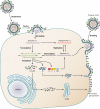Human Metapneumovirus: lessons learned over the first decade
- PMID: 21976607
- PMCID: PMC3194831
- DOI: 10.1128/CMR.00015-11
Human Metapneumovirus: lessons learned over the first decade
Abstract
It has been 10 years since human metapneumovirus (HMPV) was identified as a causative agent of respiratory illness in humans. Since then, numerous studies have contributed to a substantial body of knowledge on many aspects of HMPV. This review summarizes our current knowledge on HMPV, HMPV disease pathogenesis, and disease intervention strategies and identifies a number of areas with key questions to be addressed in the future.
Figures




References
-
- Aberle J. H., Aberle S. W., Redlberger-Fritz M., Sandhofer M. J., Popow-Kraupp T. 2010. Human metapneumovirus subgroup changes and seasonality during epidemics. Pediatr. Infect. Dis. J. 29:1016–1018 - PubMed
-
- Aberle S. W., Aberle J. H., Sandhofer M. J., Pracher E., Popow-Kraupp T. 2008. Biennial spring activity of human metapneumovirus in Austria. Pediatr. Infect. Dis. J. 27:1065–1068 - PubMed
-
- Agapov E., Sumino K. C., Gaudreault-Keener M., Storch G. A., Holtzman M. J. 2006. Genetic variability of human metapneumovirus infection: evidence of a shift in viral genotype without a change in illness. J. Infect. Dis. 193:396–403 - PubMed
Publication types
MeSH terms
Grants and funding
LinkOut - more resources
Full Text Sources
Other Literature Sources

